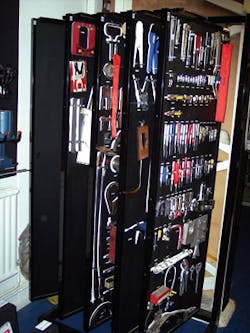It’s a matter of fact – tool control affects safety. Leaving a tool in an aircraft or engine is not just an inconvenience, it is a safety risk. Realizing this, most aircraft maintenance businesses enforce some sort of tool control procedures. They realize that establishing and enforcing a tool control program can provide numerous benefits, the foremost of which is safety. In this article we will take a look at some ideas inherent to an effective tool control policy.
What’s involved?
At a minimum, tool control is a method to quickly determine that all tools are accounted for at the end of a maintenance task. This can only be done if each tool has a specific place where it is stored that allows for quick identification if the tool is missing. There are several ways to do this.
Tool shadowing
This involves specifying a specific space for each tool. It should be designed in such a way as to quickly determine if a tool is missing. A popular method is to use some type of foam product and cut out spots for each tool. In a toolroom environment, walls can be used with pegboard and hooks. The item is then outlined and shadowed.
Tool identification
Some companies require employees permanently mark their tools for tool identification purposes. This provides a way to quickly identify who a tool belongs to when it is found. Tools can be marked using a vibra-peen tool. Some other marking methods such as permanent marker may not be very effective in a hangar environment.
If your company requires mechanics to mark their personal tools in a uniform method, be careful of the requirement. It would be best to use mechanics’ initials or the last four digits of their Social Security number as a tool ID marking. Company specific numbers such as employee numbers should be avoided. If the mechanic changes jobs to another company, these numbers will not be relevant, and he or she may have to mark them all over again. Dan Pradel, engine services manager for Landmark Aviation, discusses his company’s tool marking requirements. “We require tool shadowing for all tools and provide the employees with foam so that they can shadow their tools in their toolboxes. In addition, we require all tools to be marked. We are flexible in the marking requirements because we realize that our mechanics come from different backgrounds and may already have markings on their tools. So we just ask that all their tools be identified by some marking, whether it is their initials, the last four numbers of their Social Security number, or some other unique identifying method.”
If employees are required to mark their personal tools, it can be useful to maintain a tool identification log in a central location (maintenance control or quality assurance for instance). This log would list all the employees and the identification that they are using to mark their tools. This way if a tool is found, the log can be referenced to find out who owns the tool.
Marking tools serves two purposes. First of all, it ensures that if a tool is found it is returned to the owner. Second, it helps assure compliance with missing tool reporting. It makes employees become more vigilant in reporting missing tools vs. just going to the closest tool truck or store to buy a replacement.
Tool inventory
A tool inventory should be accomplished on a regular basis so that any missing tools can quickly be identified and searched for before they affect the safety of an aircraft. This can be done after each work task or at least once a day. Many companies choose to do it at the beginning and end of each shift.
Tool inspection
An important part of tool control that can easily be overlooked is tool inspection. Tools should be inspected before and after each use to ensure they are in proper working order and no parts are missing. If this is not done, it can be easy for a piece of a tool to be left behind in a work area. David Smith, director of quality assurance, U.S. maintenance for Jet Aviation, discusses his company’s tool inspection requirement. “We require mechanics to inspect all tools and equipment before and after each use. This is written in our standard operating procedures manual. This policy helps ensure that no pieces from a broken tool are left in an aircraft or engine after maintenance is performed.”
Missing tool reporting
An important part of any tool control program is a process for missing tool reporting. In order to achieve the goal of accounting for all tools to ensure a safe product for the customer, a culture must be present that encourages employees to report any missing tool. This procedure should be clear as to how often tools need to be inventoried, how the employee should report a missing tool, and the steps to be taken once a missing tool is reported. An important part of this is the person who has the authority to release the aircraft in the event a missing tool is not found.
RFID Tool Control
3M has introduced a tool control solution using radio frequency identification (RFID) to the marketplace. This tool tracking solution was announced at the NBAA convention this past November. The RFID tool tracking system includes tracking software, RFID tags with protective labels, and RFID handheld readers. The system is currently being installed at The Nordam Group’s Tulsa, Oklahoma, facility. Dr. Sandra Tokach, general manager for 3M’s Aerospace and Aircraft Maintenance Division, says, “For aerospace manufacturers and MRO providers alike, systems that use RFID will bring much-needed efficiencies across a wide array of processes; in NORDAM’s case, for tool tracking.”
API
API recently introduced Electronic Supply Program (ESP) to the market. This is an Internet-based software program that uses handheld barcode readers and allows customers to automate inventory control and parts replenishment. As an added feature, ESP also has a tool control module. This module allows tools to be tracked according to a customer’s needs — whether it is by work order, N-number, or employee number. It can also track tool calibration requirements and send email alerts when a tool is approaching a calibration due date.
In the end, each company must select a tool control program that works best for its needs. Whether it is a matter of shadowing toolboxes or an investment in an automated tool control system, keeping track of tools is a safety issue that shouldn’t be ignored.





